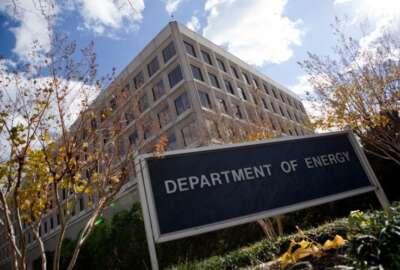Energy Department issues plan to safely and affordably replace old solar panels
Solar panels have a life cycle. The billions of panels covering roofs and once-pristine landscapes and maybe even your office building will all need to be disposed...
Best listening experience is on Chrome, Firefox or Safari. Subscribe to Federal Drive’s daily audio interviews on Apple Podcasts or PodcastOne.
Solar panels have a life cycle. The billions of panels covering roofs and once-pristine landscapes and maybe even your office building will all need to be disposed of and replaced at some point. Now the Energy Department has issued an action plan for how to safely and economically handle photovoltaic materials that have worn out. For details, the Energy Department’s photovoltaics program manager, Lenny Tinker joined the Federal Drive with Tom Temin.
Interview transcript:
Tom Temin: Mr. Tinker, good to have you on.
Lenny Tinker: Thank you very much, nice to be here.
Tom Temin: So I didn’t realize these things don’t last forever, but they don’t what happens? How do they wear out?
Lenny Tinker: Well, there’s a lot of different ways that they can actually wear out. Typically, what happens is that, you know, they’re outside sort of, they’re exposed to like the elements. And so different things can happen through thermal cycling, cracks can propagate, contacts can oxidize. But effectively, the energy output of the system starts to decrease over about 20 to 30 years is the expected lifetime.
Tom Temin: All right, and then inside these materials that actually produce the current, are these hazardous materials? Are they safe to handle? What are the issues?
Lenny Tinker: Well, there are a variety of different materials inside the modules themselves. Mostly, the modules are totally safe. But there are some materials that are used that can be actually dangerous. For example, lead can be used in the solder, like many of the electronics that we all use. And therefore it’s important that people follow EPA regulations and testing for how to deal with the materials.
Tom Temin: Got it. And is the disposal generally carried out by commercial companies locally? Suppose I have a building and there’s a lot of photovoltaics cells, they have to be removed, who does that kind of work in general?
Lenny Tinker: So that work is typically contracted out and the disposal themselves depending on the actual modules being used. So they’re these tests that are regulated by the EPA known as toxicity characteristic leaching protocols, or TCLP. So those modules would be tested, that would then determine how they had to dispose of whether or not they’d be considered hazardous waste, or it could be disposed of as just general landfill waste. And then typically, someone would contract at someone to actually take down the system and then dispose of it appropriately.
Tom Temin: All right, so what are the dangers here and tell us about the action plan, what is the Energy Department trying to do here with the action plan?
Lenny Tinker: So our goal with the action plan is to indicate for the community and to set a direction for how we could be even better than the regulations that I mentioned that are stipulated by the EPA. So we see there’s potentially a possibility to improve the way that materials are disposed of, and actually increase the recycling potential of the entire system. Now, the bulk of a PV system is steel, and aluminum and copper. And the recycling procedures for that are pretty well worked out the current industry, but the modules themselves because they’re composites and composite materials are a little more complicated, there’s some opportunity to figure out how to better recycle and recover the value of those modules. And so in our action plan, we lay out a direction for research that can be done as well as stakeholder engagement, and aggregating data. So everyone’s aware of what’s actually going on with the modules such that we can, you know, make PDS as good for the environment as possible.
Tom Temin: And of course, when you do recycling carefully, and removal and recycling, it can be expensive. And so is the economics of this part of the calculus?
Lenny Tinker: Oh, absolutely. The economics are the foundation of a lot of the decisions that people are making in terms of energy and actually disposal of systems. So right now, recycling can be about almost 10 times as expensive as just general disposal. And so we’re trying to do is look at you know, like I said, how can you better recover value out of the modules when you recycle them? Because that, of course, helps pay for the recycling itself? And also, how can you develop modules and produce them in a way that makes it even easier to separate?
Tom Temin: We’re speaking with Lenny Tinker. He’s an Energy Department of photovoltaics program manager, part of the DoD’s Solar Energy Technologies Office. And the materials that are rare that are in these might be outsourced, originally from the United States, is there the possibility that by recycling properly, we could almost develop a source of rare materials from an effect mining the old solar panels right here in the United States?
Lenny Tinker: Absolutely, there’s opportunity to recover rare and valuable materials from photovoltaic systems. The bulk of the system as a whole is, like I said, steel and aluminum and copper. Now, that’s the system. In the modules, there’s some more precious materials such as silver, which is used on the front to collect the electricity. There’s also small amounts of other materials depending on the module, such as tellurium, which could be recovered. The absolute magnitude of what could be recovered from PV systems for a while can be quite low, because the majority of systems deployed right now, over 75% of them have been deployed in the last five years. And and with an expected lifetime of 25 to 30 years or maybe even longer, there’s not a lot to quote unquote mine now. But that being said, there is an opportunity to recover those materials when the time comes for decommissioning.
Tom Temin: Sure, mining was my word, but the idea they could at some point in the future be recovered and reused to make new panels?
Lenny Tinker: Absolutely. One of the main goals of the Department of Energy SET office is to make sure that we recover as much value out of the system, which helps the economics on the levelized basis for electricity. So it can be even cheaper than it is today.
Tom Temin: All right, and this action plan then who is it specifically aimed at?
Lenny Tinker: The action plan is aimed at all of our stakeholders, it’s a way for us to signal to people that would apply to our office, as well as people that are involved in the solar industry, and in policymakers for what we see as an opportunity and a future direction for sort of waste management.
Tom Temin: Yeah, so this could be kind of a new niche industry in waste management, if it’s done properly. Fair to say?
Lenny Tinker: Yeah, absolutely. Absolutely. And there’s already companies today looking at how they could get into this industry.
Tom Temin: And does DOE have any sense of the tonnage or square footage or ounces, I don’t know what the right measures are, for these materials that will be eventually need to be recycled in the future?
Lenny Tinker: Yeah, so we can make predictions on the actual amount that could be released. The current administration has an ambitious goal to have 100% carbon free electricity by 2035. And in that scenario, we actually end up ramping sort of quite a bit, we still think that the amount of waste that we generated by PV systems is actually relatively low, so less than about a tenth of a percent of total waste. So we can break into the actual tonnes here and there and how that fractions out but the point is, is that it’s a significant but not extraordinarily large amount of waste.
Tom Temin: OK, and are you one of those solar panels on the roof kind of guys yourself?
Lenny Tinker: Unfortunately, with my current house, it didn’t work out. But I am a member of a community solar program where I can pay into the system and then have electricity generated from my bill
Tom Temin: Or you could put up a steeple with a windmill on top.
Lenny Tinker: That would be a lot more challenging, and definitely not as scalable as a PV system, which can be made almost any arbitrary size.
Tom Temin: All right, Lenny Tinker is a photovoltaics program manager at the Energy Department. Thanks so much for joining me.
Lenny Tinker: Yeah. Thanks so much for having me. I appreciate it.
Copyright © 2025 Federal News Network. All rights reserved. This website is not intended for users located within the European Economic Area.
Tom Temin is host of the Federal Drive and has been providing insight on federal technology and management issues for more than 30 years.
Follow @tteminWFED






